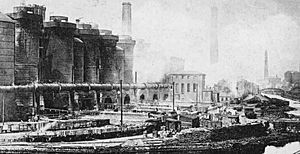Summerlee Iron Works facts for kids
The Summerlee Iron Works was a big factory in Coatbridge, Scotland, that made iron. It operated from 1836 to 1930. Today, the place where it stood is part of the Summerlee, Museum of Scottish Industrial Life, which teaches people about Scotland's industrial past.
How Iron Was Made
The Summerlee Iron Works was one of the first places to use a new invention called the 'Hot Blast Process'. This clever method was invented by James Beaumont Neilson in 1828.
Before this, iron factories used cold air to help their furnaces burn. But Neilson's idea was to heat the air first! They did this by burning waste gases from the furnaces. These hot gases would warm up special bricks inside tall towers called regenerative stoves.
Once the bricks were super hot, they would switch the gases. Fresh air would then blow over the hot bricks, getting heated up before going into the furnaces. This "hot blast" made the furnaces work much better and saved a lot of fuel!
The very first stoves were small and rectangular, but they are gone now. Later, around the 1870s, Summerlee installed huge, round towers called Cowper Stoves. These were as tall as the furnaces themselves, about 20 meters (that's like a six-story building!). You can still see the foundations of these big stoves today.
The iron works closed down in the early 1930s. This happened during a very tough time called the Great Depression, when many businesses struggled. The factory was taken down in 1938. More parts were removed in the 1950s when a crane factory was built there.
Digging Up the Past
People have dug up the Summerlee site to learn more about the old iron works. This is called an excavation. The first big dig happened between 1985 and 1987. Another excavation took place in 2000 by a team from Glasgow University.
During these digs, they found four furnace hearths. These are the bottom parts of the furnaces where the iron was melted. They also found parts of the furnace bank wall. These discoveries are the most important remains of the old iron works that you can still see today.


